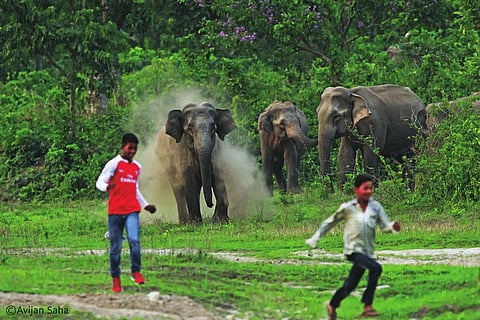Increasing Man-Animal Conflicts: Indian Elephant Fighting A Losing Battle For Habitat
Agra, April 21 (TNA) With the increased number of man-animal conflicts in different parts of the country, nature conservationists are wondering how the increasing population of pachyderms would cope with expanding urbanisation that has vastly reduced their natural habitat. Leopards, tigers, and tuskers are frequently entering urban areas and attacking humans.
In many parts of the country, new urban clusters and industrial areas have come up on the fringes of wildlife sanctuaries. From the Nilgiris in the south to the foothills of the Himalayas up north, the elephant corridors for free passage, are coming under pressure. In many areas, tourist spots and resorts have invaded the elephant territory.
“Though after the Veerappan threat was eliminated on the Tamil Nadu-Karnataka border and with effective anti-poaching measures, the population of elephants in India has seen an increase, road and train accidents have become more frequent taking a heavy toll,” says animal lover Mukta Gupta of Mysuru.
According to a rough estimate, India has around 25,000 to 29,000 elephants in the wild and around 1200 tuskers, the highest in Karnataka. Around 500 elephants have died due to unnatural causes in the last five years. In 1980, India had only 16,000 elephants. In India, there remain over 2,600 elephants in captivity.
Nature lovers say that the plight of the elephants is a critical issue requiring urgent attention, as these majestic creatures are facing numerous threats, including habitat loss, human-elephant conflict, poaching, and exploitation. Preserving and restoring elephant habitats is crucial for their survival. As human populations expand into elephant territories, conflict between people and elephants increases. Experts say that poaching for ivory and other body parts continues to pose a serious threat to Indian elephants.
When in captivity, one of the biggest hazards that elephants have to undergo is deplorable foot conditions. Saved from street begging, the industries of wedding and tourism, and circus elephants, elephants are not only found with terrible wounds across their body but also with joint problems like ankylosis and osteoarthritis. Their footpads are usually worn out, with some even having extremely thin soles, say veterinarians of the Wild Life SOS.
“Elephants in captivity suffer from prominent feet-related ailments such as abscesses, foot rot, overgrown nails and cracked footpads. While footpad injuries can include cracks, cuts, bruises or abrasions, foot rot is due to bacterial or fungal infections. Elephants also suffer from issues with their toenails such as abscesses and overgrown nails. These foot ailments impact their locomotion regarding their regular daily life,” the doctors explained.
Wildlife SOS has provided foot care to over 40 rescued elephants at its centres. To further promote outreach of elephant conservation and research, caregivers and biologists from around the world are invited to visit the facilities and observe the practicalities of elephant veterinary care. The NGO is also involved in providing medical assistance to elephants outside the centres, through its mobile veterinary unit.
Dr. Ilayaraja S, Deputy Director- Veterinary Services, Wildlife SOS explained, “We inspect the feet of elephants for indications of infection or injuries. We carry out regular foot cleaning where we remove dirt, debris and other hazardous substances that may accumulate in their sole. 40-year-old Emma is a female elephant who was found with sharp stones, pebbles, metal scraps and glass shards embedded in her footpad. For such critical cases, we create special shoes for elephants with medicines in them, which help them during their walks too.”

